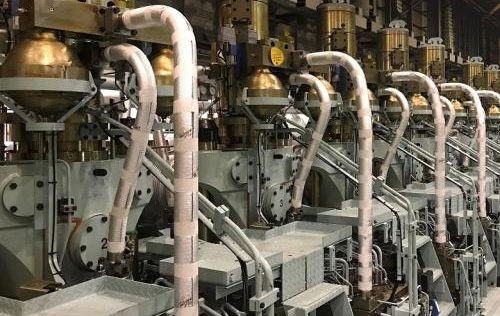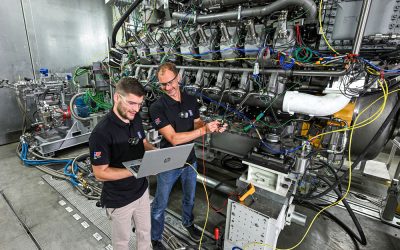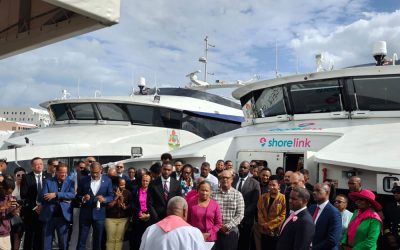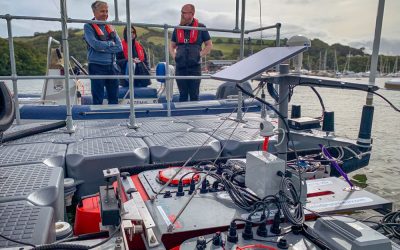With engine development almost entirely switched to evolving engines to suit new fuel types, new product offerings have been few and far between recently. In March this year, MAN Energy Solutions demonstrated its first ME-GA dual-fuel Otto cycle engine in Copenhagen. After concentrating on Diesel cycle two-strokes for decades, the decision to develop an Otto version was clearly a response to increasing sales of X-DF engines by rival WinGD. The company said that it plans to start testing the first, commercial ME-GA design by the end of this year, with the first engine delivery following in early 2022.
While the ME-GA engine opens another sales avenue for two-stroke dual-fuel engines for MAN, it is also notching up successes with its Diesel cycle variant, the ME-GI, breaking into new market segments and accelerating sales. Last October, Singapore-based Eastern Pacific Shipping ordered five 6G70ME-GI Mk 10.5 dual-fuel engines in connection with the construction of five 210,000dwt Newcastlemax bulk carriers. In May this year, the same owner came back with a new order for three more 6G70ME-GI engines for a trio of similar vessels.
In March, MAN entered the VLCC segment with an order for 10 dual-fuel 7G80ME-GI Mk9.5 engines from DSME to power 300,000dwt VLCCs for three different owners. Within weeks, a second significant order was announced when Samsung Heavy Industries confirmed an order for 10 of the 8G95ME-GI10.5 engines for a series of 15,000TEU container ships for Seaspan Corporation. The vessels are scheduled for delivery in the first half of 2023 and will go on 12-year charters for ZIM Lines. These engines will feature a newly introduced PVU (Pump Vaporiser Unit), which ensures an optimal integration between the engine and LNGsupply system.
In July, MAN announced that a six-unit order for MAN B&W 11G95ME-GI Mk10.5 engines for 23,500TEU ships for Hapag-Lloyd placed in December 2020 was to be doubled as the German shipowner had exercised options for a further six vessels.
MAN’s first dual-fuel foray into the container sector was back in 2015 when it supplied the engines for the first ever dual-fuel boxship TOTE’s Marlin class Isla Bella although the order had been made two years earlier. Despite its successes in this sector, it has not been unchallenged. WinGD claimed the contracts for the first ULCVs to be dual-fuelled when it won the order for the nine-ship CMA CGM 22,000TEU series back in 2017.
The last of those vessels, CMA CGM Sorbonne, was handed over at the end of June. The French ships were fitted with the X92DF, WinGD’s largest dual-fuel engine, but it also produces smaller versions and in February this year expanded its popular X72DF with four new variants.
New variants of old favourites
Although engine development has been mainly directed into new fuel types rather than new engines, some evolution of long-established engines has also been evident. In April this year, Rolls-Royce delivered the first ever 16-cylinder versions of the successful MTU Series 8000. The two 16V 8000 M71L engines capable of producing 72,800kW were destined for patrol vessels for the Taiwanese Coast Guard. Rolls-Royce has also already sold further engines of the new type to a second customer. The 16V engine thus continues the success story of the MTU Series 8000: with an output of up to 10,000kW, its big brother 20V 8000 has been the best-selling engine in its power class since its introduction around 20 years ago.
Another evolved engine is MAN Energy Solutions’ Mk3 6L23/30H. The base engine of the 23/30 series debuted in 1965 and more than 12,000 have been sold since then. The new Mk3 variant is a cost-effective genset that complies with 2020 SOx regulations and has a power range of 500-1,800kW. Compared with its Mk2 predecessor, among other characteristics, it features increased power output per cylinder, reduced fuel consumption, a two-part piston design for quicker maintenance and an improved conrod design.
The first references were gained this year when STX Engine signed a contract with Daehan shipbuilding for three gensets each for a one vessel and an option. The engines will achieve Tier III emission levels with the aid of SCR. They are provisionally scheduled for delivery in August 2021.




